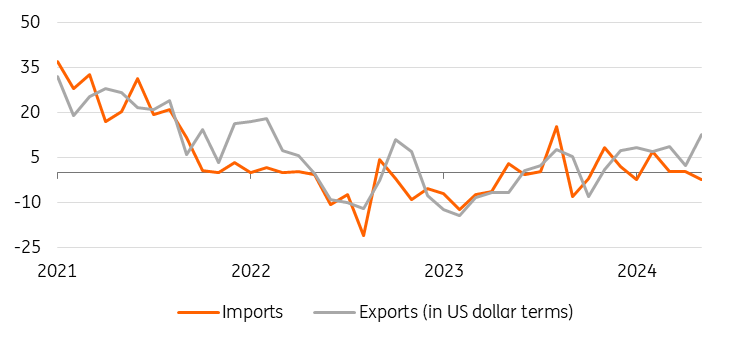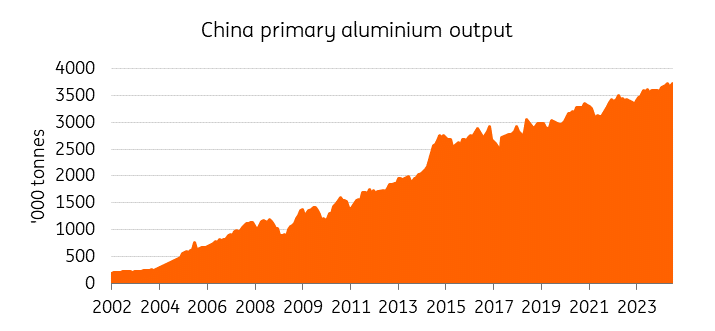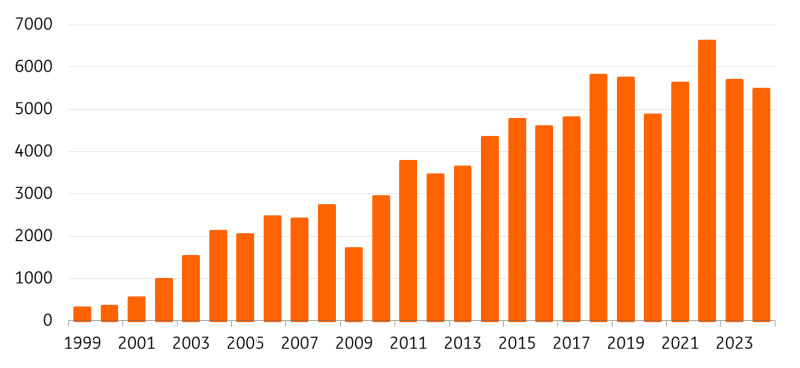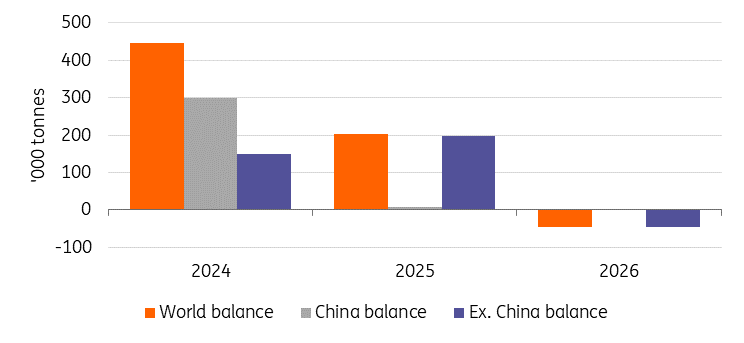The export tax rebate was also removed for copper and lowered for some refined oil, solar, battery and non-metallic mineral products (to 9% from 13%).
What are the global trade implications
China introduced tax rebates in 1985 to make Chinese products more competitive in international markets and over the years the policy has gone through various adjustments. By refunding export taxes, Chinese companies could offer their products at lower prices in international markets, increasing their attractiveness to foreign buyers, while also boosting China’s exports volumes and supporting economic growth.China’s exports growth surged in October to the fastest since July 2022, driving its trade surplus to the third highest on record. The strength in exports has helped to offset the weak domestic demand. But that has also led to a backlash from the country’s trading partners.
China exports jump in October
 Source: China’s General Administration of Customs, ING ResearchChina is under significant scrutiny for its trade practices, not only from the US but also from the EU. In May, the Group of Seven nations said Beijing was hurting the economies of its trade partners through its “comprehensive use of non-market policies and practices.” Between March 2020 and the end of 2021, more than 90,0000 companies in the country enjoyed 37.7 billion yuan ($5.2 billion) in export tax rebates, according to a report from state media China Daily, citing data from the State Taxation Administration.Recently, , citing unfair state subsidies that allowed Chinese manufacturers to undercut European competitors.This pressure might have led China to eliminate subsidies considered unfair by its trade partners.Negotiations between the EU and China are still ongoing, seeking an alternative to extra tariffs on EVs effective since 31 October 2024. This could also be a strategic power move, demonstrating China’s crucial role in global markets and its ability to influence prices and demand, in the context of trade tensions following Donald Trump’s win in the US presidential elections, which China might use as a leverage in trade negotiations. The price increase in metals across the board might speak rather in favour of the former.
Source: China’s General Administration of Customs, ING ResearchChina is under significant scrutiny for its trade practices, not only from the US but also from the EU. In May, the Group of Seven nations said Beijing was hurting the economies of its trade partners through its “comprehensive use of non-market policies and practices.” Between March 2020 and the end of 2021, more than 90,0000 companies in the country enjoyed 37.7 billion yuan ($5.2 billion) in export tax rebates, according to a report from state media China Daily, citing data from the State Taxation Administration.Recently, , citing unfair state subsidies that allowed Chinese manufacturers to undercut European competitors.This pressure might have led China to eliminate subsidies considered unfair by its trade partners.Negotiations between the EU and China are still ongoing, seeking an alternative to extra tariffs on EVs effective since 31 October 2024. This could also be a strategic power move, demonstrating China’s crucial role in global markets and its ability to influence prices and demand, in the context of trade tensions following Donald Trump’s win in the US presidential elections, which China might use as a leverage in trade negotiations. The price increase in metals across the board might speak rather in favour of the former.
China aluminium output hits record
 Source: NBS, ING Research
Source: NBS, ING Research
While its aluminium exports soar
 Source: Customs General Administration PRC, ING ResearchWhat does it mean for the aluminium marketIn the near term, the cancellation of rebates will make Chinese aluminium more expensive on the international market and could lead to a reduction in export volumes. Chinese aluminium exports have surged over the past two decades. In the first half of 2024, they rose 13% year-on-year.This recent move could also lead to a shift in trade dynamics – countries that rely heavily on Chinese aluminium might have to look for alternative supplies to fill the gap left by reduced Chinese exports. However, the capacity for output growth elsewhere is limited. China is the biggest producer of aluminium. Last year it produced around 40 million tonnes of the metal, which accounted for more than a half of the total global production. The global aluminium market is expected to return to deficit from 2026.
Source: Customs General Administration PRC, ING ResearchWhat does it mean for the aluminium marketIn the near term, the cancellation of rebates will make Chinese aluminium more expensive on the international market and could lead to a reduction in export volumes. Chinese aluminium exports have surged over the past two decades. In the first half of 2024, they rose 13% year-on-year.This recent move could also lead to a shift in trade dynamics – countries that rely heavily on Chinese aluminium might have to look for alternative supplies to fill the gap left by reduced Chinese exports. However, the capacity for output growth elsewhere is limited. China is the biggest producer of aluminium. Last year it produced around 40 million tonnes of the metal, which accounted for more than a half of the total global production. The global aluminium market is expected to return to deficit from 2026.
Global aluminium market will return to deficit in 2026
 Source: ING ResearchMeanwhile, end-users might also have to face higher costs for their raw material, which could be eventually passed on to consumers. This could have an effect on the automotive, construction and packaging industries.In the longer term, this policy change could lead to further shifts in global trade dynamics, benefitting other commodity producers as countries try to diversify their raw material source dependency on China.LME aluminium prices surged as much as 8.5% on Friday following the announcement.More By This Author:
Source: ING ResearchMeanwhile, end-users might also have to face higher costs for their raw material, which could be eventually passed on to consumers. This could have an effect on the automotive, construction and packaging industries.In the longer term, this policy change could lead to further shifts in global trade dynamics, benefitting other commodity producers as countries try to diversify their raw material source dependency on China.LME aluminium prices surged as much as 8.5% on Friday following the announcement.More By This Author:
China Ends Tax Incentives On Aluminium Exports

